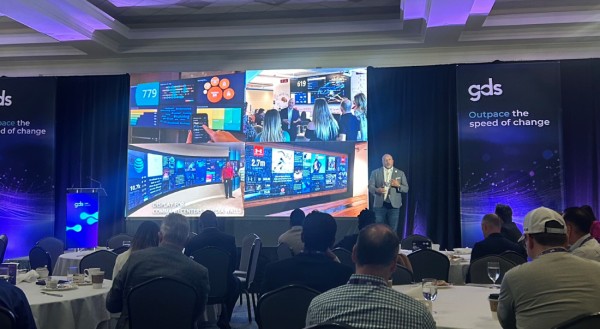“Digital transformation”, “AI”, “cloud computing” and “automation” have dominated the headlines and operational priorities over the course of the last 12 months. The twists and turns of the COVID-19 pandemic have pushed businesses towards greater agility as they rush to understand the digital-first consumers, in short, there is no single organizational function that hasn’t been forced to innovate, therefore, building a digital transformation framework has become vital.
On one hand, the sales & marketing teams have had to adapt from a hybrid-online and offline relationship with their prospects and customers to one almost exclusively digital. Equally, IT teams have had to traverse new cybersecurity challenges, rapidly adopting new cloud-based solutions for remote working, whilst also dealing with the influx in requirements for online systems.
This article looks at the digital transformation framework, its importance, the benefits therein, and how executives are realizing and continually building upon its potential impact. By understanding each of these core facets, any organization can strategically reposition both their brand and their organization for the new digital economy.
Defining Digital Transformation
According to CISCO, digital transformation is the application of smart technology ‘to build new business models, processes, software, and systems that bring connectivity and visibility into every aspect of the organization’ with the aim of enhancing everything from internal processes to customer experiences. Essentially, digital transformation helps organizations to scale in the digital economy, to become more profitable, and to increase potential to deliver to its outcomes.
How Does a Digital Transformation Framework Help?
Customer behavior is everchanging. Today’s prospects, clients and buyers are more informed than they’ve ever been and leverage the internet to learn more about a brand, their value proposition and whether they align with their requirements. As customer behavior changes, companies must too – by adapting their operations and the way they win business; a core part of that will be by leveraging emerging technology.
The Benefits of an effective Digital Transformation Framework
The advantages of effective digital transformation are innumerable and enable business to:
- Streamline operations & customer service
- Increase employee efficiency
- Reduce overhead costs
- Build a scalable and sustainable future
- Stay relevant to customers with personalized, impactful experiences
In the post-pandemic, we will again have to constantly assess the economic, social and organizational challenges that present themselves, but with the right technologies and systems in place, businesses will be able to meet their prospects evolving expectations with greater accuracy and more meaningful depth.
How to Build an Effective Digital Transformation Framework
Digital transformation is an ongoing process and one that can only be built out once an extensive technological audit has taken place, one which looks at every element of your technological stack and concurrently identifies any gaps where your systems could be improved.
Are you lacking in CRM? Digital asset management? Marketing systems? Could you streamline your lead scoring or customer engagement platforms? Improving and evolving processes and systems for attraction, engagement, analysis, and optimization will need the buy-in of people at all levels of management within an organization. To this end, educating staff and constructing a clear vision will give organizations a solid foundation to build on as a team.
Successful digital transformation requires a fully realized IT stack which works for the evolving digital workforce, a connected and personalized user experience for the end-user, and the software necessary to organize the huge amounts of data that are produced out of the buying process. In short, businesses that both leverage new technologies and partner with experts early will be those best situated for the future.
An effective digital transformation framework depends on the groundwork you establish for yourself and really, the earliest stages of strategy formulation needn’t be more complicated than that. What differentiates the laggard from the leader when it comes to a digital overhaul is the information that they use to inform its earliest stages, to this end, conducting a full and regular audit of the resources you have in play is the best way to equip executives with the tools necessary to implement lasting change. Once this research has taken place however, what should your organization’s next steps be?
5 Tactics Top C-suite Executives use to Drive their Digital Transformation Framework
We’ve established that digital-first is the future. The global pandemic has forced leaders and senior executives to evolve and upgrade the fundamentals of their organization’s systems and processes. Senior executives have fast realized that the utilization of smart technologies such as cloud-computing systems, marketing automation systems, big-data and customer engagement platforms are the best means of staying agile in a digitally altered world.
There are five key areas in which top executives consistently bolster their digital transformation framework:
1. Implementing a Digital Business Culture
The world has changed drastically in the last 12 months. The coronavirus pandemic and social distancing have forced employees out of the office and customers online. The change has been so drastic in fact, that McKinsey predicts that in a matter of eight weeks after the outset of the pandemic, consumer and business digital adoption leapt in progress by about five years.
Economic uncertainty and a lack of predictable outcomes have forced business leaders to innovate on the fly and adapt to the evolving needs of their customers whilst projecting what their needs will look like after COVID-19. However, broad sweeping changes within an organization are prone to be met with resistance. Prior to the institution of any dramatic digital change projects, it is essential that you first ensure your organization is aligned to face that change.
Nurturing a cultural shift requires the buy-in of members across every level of management and leaders are now beginning to identify and rally respected champions within their business to help others adopt new and emerging technologies. Effective means of inspiring a digital culture include:
- Have your HR team develop your internal communication potential, reduce surprises
- Prioritize agility in staff and leadership alike, help them to respond quickly and dynamically
- Train staff on any new technologies and provide the necessary technological support thereafter
- Prepare leaders across the company for its impact as well as their impact on its adoption
2. Building an Effective IT Infrastructure
Continual development of your IT stack will be key to digital transformation as a greater proportion of employees and customers move towards life online. For example, Computer Weekly reported ‘SaaS collaboration and communication technologies – zoom, teams, and google meet… quickly bridged the gap for businesses and societies to stay connected during lockdown’, also proving detrimental to facilitating the shift to remote working.
Equally important is investment in the cloud stack, for example, Synergy Research Group have revealed that 2019 marked ‘the first time that enterprises spend more on cloud services (IaaS, PaaS and hosted private cloud) than they do on data center equipment’. This was borne out in the statistics with the cloud infrastructure market growing to a value of $129 billion in 2020, up 35% from that same time in 2019.
It’s a trend expected to gather pace in the next decade, with Gartner predicting that by 2024, more than 45% of the IT budget will be spent on system infrastructure, infrastructure software, and application software.
Finally, with an increase in those working remotely, cybersecurity concerns have risen in prevalence. For example, between January and April 2020 cyberattacks on banks rose by 238% whilst breaches on cloud servers increased by 630% with hackers looking to exploit the situation surrounding Covid-19. In addition, it is imperative that organizations protect themselves and enhance their cybersecurity posture not just for their sake but for the sake of their customers.
Consumers vote with their wallets and companies can’t afford to slip, as Veritis Group reported, more than 4000 brands found customers had lost trust when businesses failed to protect their data.
3. Forming a Data-Driven Organization
The ability to use data for continuous improvement is a key component in successful digital transformation and C-suite execs have grown increasingly aware of its impact. In short, poor data costs companies. For example, Gartner found that organizations see poor data quality as responsible for $15 million of their yearly financial losses on average, whilst IBM found that bad data cost the US $3 trillion in 2016, twice Canada’s GDP for the same year.
It’s a frankly baffling statistic and illustrates the importance of an effective data posture in the modern business. Conversely, digitally-driven organizations are 19 times more likely to be profitable. Companies must now arrange huge volumes of real-time data from multiple sources and action insights from it and the best means of doing so is by scaling using Artificial Intelligence.
The application of AI is all around us; from online ads based on previous shopping experiences or search history to the manufacturing industry where Industry 4.0 trends are automating factories with robots and smart technology to make production output predictable and more efficient. Senior executives in all industries are partnering with experts to streamline their customer data platforms, CRM systems, marketing automation and sales enablement platforms, and every business must follow suit if their digital transformation framework is to be successful.
4. Putting Empathy and Personalization at the Heart of Customer Experiences
Automation is not only useful for aligning your teams and wider business to the data-driven approach however, increasingly it is being used to transform the experiences provided to customers. Now more than ever, consumers crave authenticity, and they look for the brands that are best placed to provide it. To this end, AI must be used hand-in-hand with empathy to define your process.
When it comes to the contemporary purchasing process, customers want to feel engaged and understood and this will come to define what they consider to be an impactful customer service. We’re already seeing businesses coming up with new and innovative ways to show prospects that they understand them and notably, the pandemic has had a substantial impact on the conversational AI market.
According to Intrado, we can expect the conversational AI sector to grow from $4.8 billion in 2020 to $13.9 billion by 2025. It’s a development that we can already appreciate with IBM noting a 40% rise in traffic to their Watson assistant between February and April 2020, whilst chatbot companies such as Ubisend use AI and open API’s to learn about brands from their website and interactions from prospects to streamline the conversational experience and drive conversion.
In addition, marketing automation systems such as Marketo also have plug-ins for web-personalization based on known data about a contact when they visit a company’s website.
Whatever technology is used to help create a personalization, the experience must be consistent and reliable.
5. Making the most of Marketing
As part of Adobe’s 2021 Digital Trends Report the company stated that ‘2020 will go down as the year that marketing was pulled into the boardroom’, with 80% of senior executives saying the role of marketing in a strategy setting had expanded since the onset of the pandemic.
It cannot be refuted that marketing to digital-first consumers has raised the profile of digital, content, and web marketing functions whilst highlighting a need for marketing automation and lead scoring platforms to lessen the load on sales teams. Systems such as Marketo are now able to create prospect profiles and assign smart scores to otherwise invisible web prospects and, when they become known contacts, businesses can assign scores to certain behaviors such as webpage browsing, gated content download or contact form fills.
From there, as companies build more and more data about their prospects interactions’ they can target them with smart email campaigns or funnel the lead into a company’s CRM system ready to be handed onto sales. The benefit here is companies can now drill down even further into trends and behavior to streamline marketing funnels; marketers are uniquely disposed to provide insights into the digital-first consumer and translate an organizations plethora of data into actionable intelligence used to engage this audience.
Now, more than ever, marketers have a significant hand to play in the success of an organization’s digital transformation process.
Conclusion
The Digital transformation process is never complete; there is always something that a company could be doing to ensure that it remains ahead of the digital curve and to that extent, organizations must constantly assess and reassess their technological position. The five points listed above represent the most effective means of your company successfully self-examining its position in this process, by attending to these tactics you can not only ensure that your digital transformation framework works for you but will continue to do so in the coming weeks, months, and years.
To learn more about digital transformation and converse with like-minded executives join the conversation at the Digital Innovation Summit NA, a GDS Summit, where we bring together senior technology executives who are actively seeking to share, learn, engage, and find the best technology solutions.
GDS Group hosts experts to help experts. We strive to provide an atmosphere for our attendees that enable them to confidently lead their companies through major transformation projects. For information on upcoming events, view our view our Digital Summits. To remain current on our activities, visit GDS Group on LinkedIn | Facebook | Twitter.












